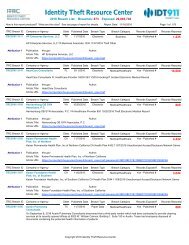Leveraging the Internet of Things and Analytics for Smart Energy Management
1UbH4b2
1UbH4b2
Create successful ePaper yourself
Turn your PDF publications into a flip-book with our unique Google optimized e-Paper software.
Realizing Holistic Benefits through <strong>Analytics</strong><br />
Here are a few ways to leverage <strong>the</strong> IoT <strong>and</strong> analytics simultaneously to realize benefits across <strong>the</strong> energy<br />
management spectrum:<br />
Asset efficiency analysis: Asset efficiency can be calculated <strong>for</strong> a variety <strong>of</strong> assets in real time. This also<br />
helps determine <strong>the</strong> cost implications <strong>of</strong> non-optimal device per<strong>for</strong>mance. The efficiency <strong>of</strong> assets can<br />
drop due to age or maintenance issues. Benchmarking techniques compute <strong>the</strong> optimal efficiency levels<br />
at which <strong>the</strong> devices should run under <strong>the</strong> given set <strong>of</strong> environmental conditions. This can be used to<br />
identify scenarios involving excessive energy consumption within a building.<br />
Root cause analysis: This can be per<strong>for</strong>med in cases where a higher than expected level <strong>of</strong> energy was<br />
consumed. Given <strong>the</strong> IoT enabled data, <strong>the</strong> hypo<strong>the</strong>sis generated through root cause analysis can be<br />
statistically validated.<br />
Predictive analytics on asset maintenance: The cost implications <strong>of</strong> maintaining all energy consuming<br />
devices can be determined using predictive analytics. Similarly, warranty lifetime analysis can also be<br />
per<strong>for</strong>med to arrive at <strong>the</strong> optimal warranty period <strong>and</strong> costs. If certain devices are observed to fail early<br />
in <strong>the</strong>ir lifecycle, <strong>the</strong> warranty tenure is expected to be long enough to cover all such early lifetime<br />
failures. Also, while <strong>the</strong> device might not be likely to fail as a whole, certain components might be more<br />
prone to failure than o<strong>the</strong>rs. Fur<strong>the</strong>rmore, warranty analysis acquires importance if <strong>the</strong> error-prone<br />
components in <strong>the</strong> device are expensive.<br />
Correction <strong>and</strong> exception analysis: Analytical techniques help identify areas where power factor<br />
correction might be required early on to enable cost savings. Analysis <strong>of</strong> exceptions, alarms, <strong>and</strong> manual<br />
overrides to EMS is important to highlight <strong>the</strong> discrepancies that are likely to be registered in operations<br />
from time to time. Such analysis helps determine <strong>the</strong> optimal state, <strong>the</strong> factors responsible <strong>for</strong> deviation,<br />
<strong>and</strong> <strong>the</strong> preventive <strong>and</strong> corrective actions required to run <strong>the</strong> automated operations optimally.<br />
Carbon emission analytics: Scenarios that help minimize <strong>the</strong> total carbon emissions from <strong>the</strong><br />
commercial buildings can be simulated using carbon emission analytics. <strong>Energy</strong> management st<strong>and</strong>ards<br />
m<strong>and</strong>ated by relevant laws can be taken into account <strong>for</strong> such simulation. This can help tailor energy<br />
management solutions according to <strong>the</strong> location <strong>of</strong> <strong>the</strong> building.<br />
9





